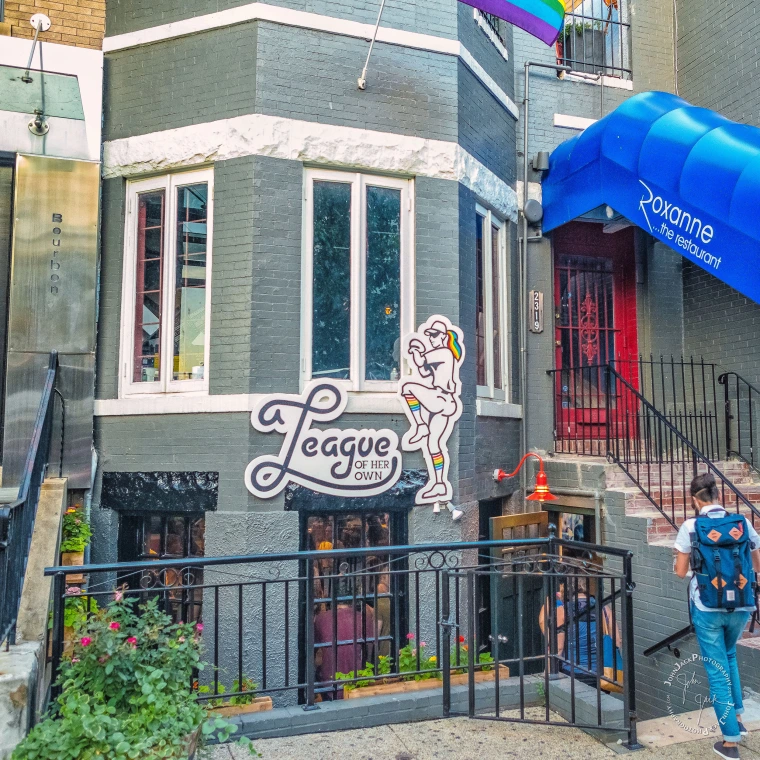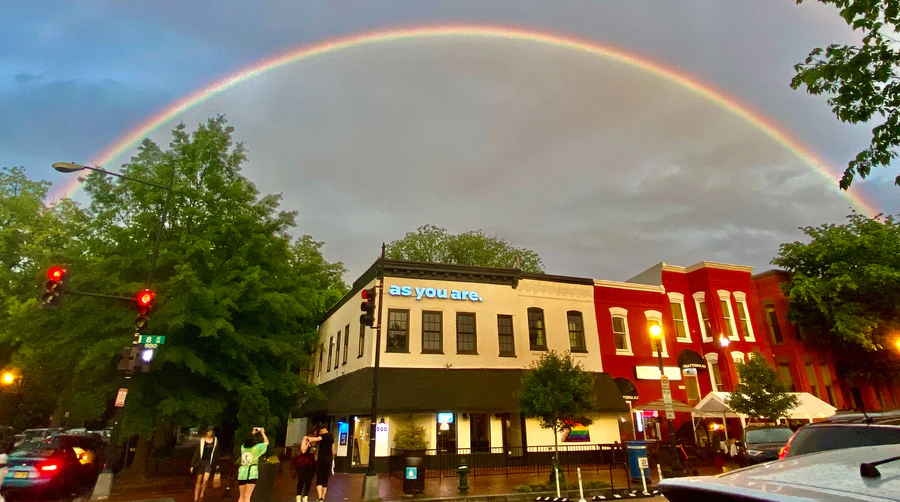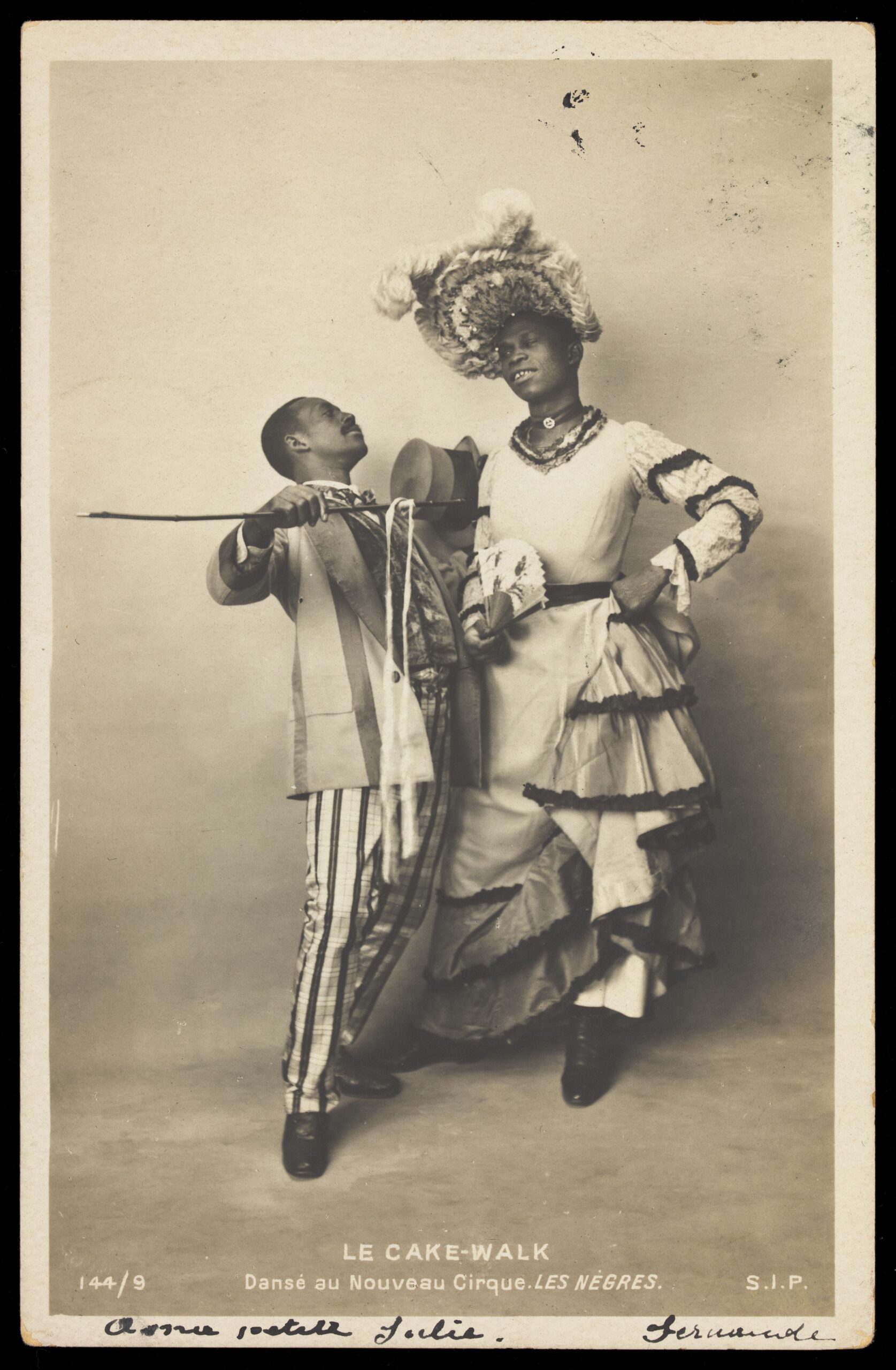"We're Here, We're Queer": Mapping Queer Spaces in DC
On June 11, 2023, the Humanities Truck parked at the intersection of 7th and E Street NW near Pride Festival 2023. This year, we brought out a new combination exhibit/interactive meant to help people learn about sites of queer history in DC going back to the late 1800s, and to help the Humanities Truck team learn about what sites in DC matter to LGBTQIA+ folks in the DMV area, from places they grew up or work, to where they met their partner or have started their own family.
After taking portraits of passersby who wanted to participate, as they were printing we asked them to think of a place that’s meaningful to them or helps them connect to their LGBTQ+ community. Once it was printed, folks who thought of somewhere responded on a prompted card, which we put on a collage wall around a map of the DMV area. From there, we place a magnet around their spot, tying string from the magnet on the map to the magnet on their photo. From this, we created a literal web of connections around DC, showing us what matters to queer people in the DMV, where they feel connected to, and how people are connected to each other in and around the city. Whether or not they had a place to share with us, everyone who added to the wall showed that, no matter the challenges being placed in front of LGBTQIA+ people today, we’ve always been here, queer people will always find and support each other, and we aren’t going anywhere.
Often, when you look up queer history in DC it starts off in the 1950s with the Lavender Scare—an aspect of McCarthy’s purging of the federal government that targeted gay men and lesbians—and the protests of the Mattachine Society that weaponized respectability to combat the Lavender Scare. But there are more stories and sites of queer existence, joy, and resistance throughout the city that go back centuries before that period. This is just a narrow selection of sites that were chosen to exhibit the diversity and far-reaching history of queer people and groups in the district, and there are tons more where these nine came from!
The Arrest of William Dorsey Swann – 1888
On April 12, 1888, William Dorsey Swann, an organizer of drag performances and early queer activism, was having a house party at 1115 F St NW—on the corner of F St and 12th St, east of the White House—with several friends and fellow drag performers. Several police officers noticed a guest entering in drag and followed them upstairs. They broke in to the apartment, and Swann did his best to block them and allow his friends to escape. He and 12 others were arrested and charged with vagrancy. No photos of Swann exist, but the vaudeville performer pictured on the left in a dress is sometimes confused to be and credited as William Dorsey Swann.
Photo: Two black actors, Gregory and Brown, one in drag, dancing the Cake-Walk in Paris. Photographic postcard, 1903. Welcome Collection
The Showboat – 1936-1947
Open from 1936-1947, The Showboat—at 1310 H St—was mostly a lesbian bar, and nightly musical entertainment was provided by a lesbian couple: Chloe and Loverboy. The clientele skewed so heavily towards LGBTQ+ people that the owners requested that World War II servicemen be steered away from the bar to avoid possible physical conflicts or other legal troubles. There are no photos of the space, with most searches coming up with a jazz bar in DC several years later, and the building has been demolished. All that’s there now is a triangle park in an intersection.
Phase One – 1971-2016
Opened in 1971 at 525 8th St SE, Phase One was the longest operating lesbian bar in the United States by the time it closed in 2016. This bar was one of several that was open on 8th St, also called the Gay Way, in that time. They were a sponsor of Capital Pride for several years and hosted a music festival called PhaseFest from 2007 through 2017. It wasn’t always rosy at Phase One, however – in 1979 they were accused of excluding black and trans patrons, earning a reputation of exclusivity that followed them for decades until its closure.
Photo: The entrance to Phase One in 2015, via DCist


The Best of Washington – 1972-present
A private club founded in 1972 by Bob Lomax and Otis Buddy Sutson, The Best of Washington provided a much safer, private space for black LGBTQ+ people to meet than more public places like bars and parks. The Best of Washington hosted tons of different events, from ritzy black tie balls to accessible and cheap All-Night Struts. Their work included philanthropy from day one, but during the AIDS epidemic they asserted themselves more publicly, providing a support system for black and LGBTQ+ folks who weren’t getting help elsewhere in DC.
The point pinned on the map—3201 Fort Lincoln Drive—is where the club held a public funeral service honoring longtime president James “Juicy” Coleman.
Photo: Chairman Otis Buddy Sutson and President James “Juicy” Coleman from a 2003 interview with Metro Weekly
The Furies House – 1971-1972
The Furies Collective was a commune of twelve lesbian separatists who lived together in a house—at 219 11th Street SE—in 1971 and 1972. All of the women had a background in activism, mostly in the women’s movement, inspiring their efforts to create a small collective separate from patriarchy and capitalism. Both while and after living in this house together, the collective also published a newspaper called The Furies that laid out their ideological arguments in favor of lesbian separatism and anti-capitalism. While there, they also raised three girls collectively, attempting to each play equal roles in their development rather than breaking into a nuclear family-like structure.
Photo: The Furies Collective in their house, via DC Historic Sites, ID 1128


The ClubHouse – 1975-1990
The ClubHouse was opened by John Eddy and Aundrea Scott in 1975 as a membership-based social space in Petworth—1296 Upshur St NW—for black queer people. While membership or an invitation was required for entrance, membership itself was free. This space served as a nightclub, performance venue, and meeting place for fundraisers and political organizations. One of these organizations was Us Helping Us, a nonprofit that created, used, and strengthened mutual aid networks that emerged in black and queer communities during the AIDS epidemic, meeting in The ClubHouse until it closed in 1990.
Photo: ClubHouse Manager Rainey Cheeks, in the white suit, founded the ClubHouse Dancers who are posed around him, via DC History Center
ENIKAlley Coffeehouse – 1982-1989
Opened in 1982 by Ray Melrose and his partner Gary, the ENIKAlley Coffehouse was a political, artistic, and social space for black LGBTQ+ folks. The owners of the coffeehouse explicitly reached out to women so they’d feel the space was accessible, and they hosted notable black queer groups like the D.C.-Baltimore Coalition of Black Lesbians and Gays and the Sapphire Sapphos, musicians including Essex Hemphill and The Four of Us, and artists like Audre Lorde and Barbara Smith. The coffeehouse closed in 1989, but a 35-minute documentary exploring it’s history and impact on DC queer spaces and art, Fierceness Served!, came out in 2021.
Photo: Darrin Frisbee and founder Ray Melrose pictured inside the Coffeehouse, from the Fierceness Served! Archive via Pride Index


A League of Her Own – 2018-present
After two years with zero lesbian bars in DC when Phase One closed down, A League of Her Own opened their doors in 2018 at 2319 18th St NW in Adams Morgan. In the basement of Pitchers (a gay sports bar), ALOHO has a wall covered in pictures of famous lesbians and queer women, and they hold events almost every night they are open to help queer women meet and hang out in a space that feels welcoming to them. This includes board game nights, speed-dating events, themed dance parties, monthly drag queen and king shows, open mics, and regular reggaeton and hip hop nights.
Photo: the entrance to A League of Her Own, via NBC News
as you are. – 2021-present
Just a few properties down 8th Street from the former Phase One, as you are opened their doors in 2021 as “a lesbian bar, and…” according to co-owner Jo McDaniels. Stationed in the historic Gay Way, AYA is both a café and a bar, and host events that range from dance parties and drag shows to book readings and speed friending. This space was chosen to connect to queer history, and provide a space for LGBTQ+ people of all ages and interests to feel welcome.
Photo: as you are. under an incredibly fitting rainbow, via as you are. website

The Community Map
While participants were waiting for their portrait to print, we asked them to write down any locations that were meaningful to them in the DMV area, if they had any. These locations ended up ranging from first date sites, to family homes, to places people go to hang out with friends. From there, we taped up their portrait with their written location, and used some colored string and magnets to connect their portrait to their spot on a printed map of DC. A map of these wonderful contributions is below! Some people didn’t have locations to share with us, but still contributed a picture and/or a drawing, so check out all of the contributions, place-based or not, in the gallery below the map!
The Zines
We also displayed QR codes that led to zines that were produced in the spring about queer history. One (left) was “Lavender Lasting,” produced by graduate fellow Morgan Carroll, which is meant to show that although recent attacks on queer people pretend that LGBTQ+ existence is new, archival photos and other resources show that queer identities always have existed and always will. The other (right) was “The Long Lesbian Life of Washington DC,” produced as a part of a practicum project by public history graduate students Logan Wills Elizondo, Mattie Branson-Meyer, Shelby Dunn, and graduate fellow Corinne Davenport. This zine digs into the history of lesbian bars in Washington DC, and how practices in them have shifted over decades around changes in legal policy and social norms regarding race and gender identity.
Sources
William Dorsey Swann
Gardiner, James. Two black actors, Gregory and Brown, one in drag, dancing the Cake-Walk in Paris. Photographic postcard, 1903. Welcome Collection. Welcome Collection. Accessed August 24, 2023. https://wellcomecollection.org/works/auv69te9.
Joseph, Channing G. “The Black Drag Queens Who Fought Before Stonewall, 1880-1900, by Channing G. Joseph.” outhistory.org, 2016. https://outhistory.org/exhibits/show/channing-joseph/drag-party.
Morgan, Marjorie. “From Slavery to Voguing: The House of Swann.” National Museums Liverpool. Accessed August 24, 2023. https://www.liverpoolmuseums.org.uk/stories/slavery-voguing-house-of-swann.
The Showboat
Anonymous. “Jo-Anna’s and Other Lesbian Bars in Washington, D.C.” Web log. Lost Womyn’s Space (blog), April 16, 2011. http://lostwomynsspace.blogspot.com/2011/04/jo-annas-and-other-lesbian-bars-in.html.
Phase One
Walker, Jerad. “D.C. Dives: Rocking out and Wrestling at Phase 1.” WAMU, October 9, 2016. https://wamu.org/story/13/04/19/dc_dives_rocking_out_and_wrestling_at_phase_1/.
The Best of Washington
“Best of Washington Social Club Materials, 22.” Rainbow History Project Digital Collections. Accessed August 24, 2023. https://archives.rainbowhistory.org/collections/show/24.
Doig, Will. “Membership’s Privileges – The Days and Nights of the Best of Washington.” Metro Weekly, September 26, 2013. https://www.metroweekly.com/2003/02/memberships-privileges/.
Dolinksy, Rebecca C. “Lesbian and Gay DC: Identity, Emotion, and Experience in Washington, DC’s Social and Activist Communities.” University of California, 2010.
The Furies
Dolinksy, Rebecca C. “Lesbian and Gay DC: Identity, Emotion, and Experience in Washington, DC’s Social and Activist Communities.” University of California, 2010.
“The Furies Collective.” National Parks Service, June 13, 2022. https://www.nps.gov/places/furies-collective.htm.
The ClubHouse
Bailey, Amber. “Historic American Buildings Survey – 1296 Upshur St, NW (The ClubHouse).” Washington: National Parks Service, 2016. https://tile.loc.gov/storage-services/master/pnp/habshaer/dc/dc1100/dc1175/data/dc1175data.pdf.
Mandeville-Gamble, Steven. “The ClubHouse, 1975-1990.” Rainbow History Project Digital Collections, 2005. https://archives.rainbowhistory.org/exhibits/show/clubhouse.
Olinger, John P. “The ClubHouse, a Remarkable LGBTQ Gathering Spot.” DC History Center, June 18, 2021. https://dchistory.org/the-clubhouse/.
ENIKAlley Coffeehouse
Dolinksy, Rebecca C. “Lesbian and Gay DC: Identity, Emotion, and Experience in Washington, DC’s Social and Activist Communities.” University of California, 2010.
Esteemfeedback. “Fierceness Served! The Story of the Legendary Enikalley Coffeehouse in DC -.” FIERCENESS SERVED! The Story of the Legendary ENIKAlley Coffeehouse in DC, July 18, 2021. https://prideindex.com/coming-soon-fierceness-served-the-story-of-the-legendary-enikalley-coffeehouse-in-dc/.
Marloff, Sarah. “A New Documentary Tells the Story of a Critical Gathering Space for D.C.’s Black LGBTQ Community.” Washington City Paper, August 19, 2021. https://washingtoncitypaper.com/article/528741/a-new-documentary-tells-the-story-of-a-critical-gathering-space-for-d-c-s-black-lgbtq-community/.


